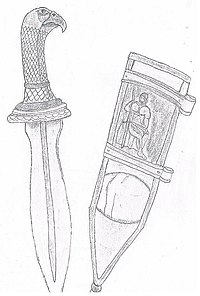Parazonium
| Parazonium | |
|---|---|

|
|
| Information | |
| Weapon type: | dagger |
| Designations: | Parazonium |
| Use: | weapon |
| Creation time: | 5th century BC Chr. |
| Working time: | 4th century - 2nd century BC Chr. |
| Region of origin / author: |
Greece |
| Distribution: | Roman Empire |
| Overall length: | 40-50 cm |
| Blade length: | 30 cm |
| Handle: | Iron, leather |
| Lists on the subject | |
A parazonium is a Roman dagger of Greek origin with a pointed blade. In the Roman Legion , it was mainly used by officers' staff as a secondary weapon alongside the gladius and was the forerunner of the Pugios .
Appearance
The parazonium was about half a meter long and its handle was often decorated with artistic decorations, such as B. an animal head. Its blade was pointed. Otherwise it resembled the later common Pugio.
history
The Parazonium came to Greece around 500 BC. BC, where it was also used as a handy dagger. However, the weapon only gained popularity when it was introduced into the Roman army at the time. At first it was used by legionaries and officers as a secondary weapon, then the military belt emerged, in which the sword was worn on the right and the dagger on the left for legionaries (it was the other way around for officers). In the 2nd century BC Then came the Pugio and replaced the Parazonium. For some time it was only used as a badge of rank by centurions . After the Third Punic War , the weapon is considered to have been replaced.
This dagger is particularly important in Roman and Greek mythology; it can be found again and again in images of Virtus or Mars, the god of war .
See also
Web links
literature
- Angela Kühnen: The imitatio Alexandri in Roman politics. (1st century BC - 3rd century AD). Rhema, Münster 2008, ISBN 978-3-930454-73-0 , p. 37f. (At the same time: Duisburg, Essen, Univ., Diss., 2005).
